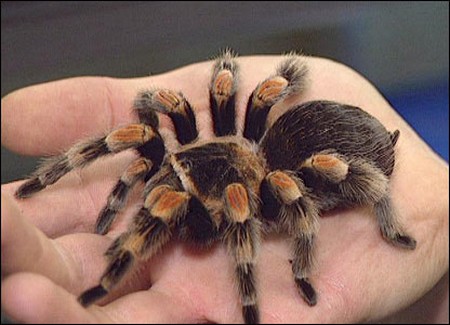Tarantulas are long-legged, long-living spiders, whose entire body is covered with short hairs. Tarantulas inhabit tropical to temperate regions in South America and Central America, Mexico, and the south-western United States, Asia, Southern Europe, Africa and the Middle East.
- HOUSING: Almost any kind of container can be used to house your tarantula – an aquarium, plastic shoe box; even a gallon glass jar will provide a home for a young tarantula. Tarantulas are excellent climbers and, no matter what kind of cage you use, a secure top is a must. This will both keep the spider in and help keep poking fingers and other potentially harmful harassment out. Several small air holes in the top and/or sides will provide enough oxygen for the spider and at the same time help maintain air circulation and humidity. If you cover the air holes with screen, be sure to use a metal screen that the spider cannot chew through easily.
- An inch or two of potting soil, or a mixture of soil, sand, sphagnum moss, or vermiculite can be used as substrate. Room temperatures, 70-75 degrees Fahrenheit or so, seem acceptable to most species. A well-maintained cage will have to be thoroughly cleaned only 2 or 3 times a year.
- FOOD AND WATER: Tarantulas are predators and will eat just about any living animal they can capture and kill. Crickets, most beetles, grasshoppers, earthworms, moths, and other animals are acceptable. Larger tarantulas sometimes eat small snakes, lizards and mice. Avoid wasps and bees, since they could harm the spider, and do not use insects from areas that might be sprayed for pests. A plastic jar lid or similar container can be a good water dish, and putting in a few small stones will let the feeder animals crawl out should they fall in. If you use a piece of sponge keep it clean, and do not use cotton (it can get caught in the spider’s mouth).
- HANDLING: It is not advisable to handle your tarantula as you may be allergic to its bite. Several tarantula species can kick defensive hairs off the top of the abdomen. If you are sensitive to these hairs, you will usually feel a slight itching. It is always a good idea to rinse your hands and arms after handling your tarantula, and to not rub your eyes until you’ve done so. Some species cause more itching than others, and individual reactions vary from person to person. It is also not unusual for a tarantula to have a bald spot on its abdomen; the lost hairs will be replaced at the next moult.
